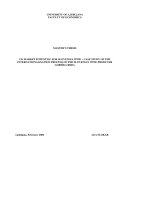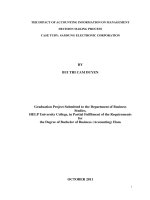Developement of Multi-Agent system (MAS) model for Bac Lieu case study
Bạn đang xem bản rút gọn của tài liệu. Xem và tải ngay bản đầy đủ của tài liệu tại đây (257.64 KB, 10 trang )
1
Development of Multi-Agent Systems (MAS) model
for Bac Lieu case study
--- oOo ---
F. Bousquet
1
, LC. Dung
2
, LA. Tuan
2
1
IRRI-Cirad, Bangkok, Thailand
2
Cantho University, Vietnam
1 INTRODUCTION
Beside the DFID project “Accelerating poverty elimination through sustainable
resource management in coastal lands protected from salinity intrusion” a
complementary modeling experiment started in September 2001. The
objective is to test the use of a new methodology using Multi-Agent Systems
for participatory modeling. This approach was initiated by Cirad (Bousquet, et
al. 1999) and has already been developed in collaboration with IRRI. For
instance this approach is developed and used by IRRI researchers in North
Vietnam for the study of farmer’s practices (Castella, et al. 2001).
MAS is a methodology which put emphasis on the understanding of decision
making processes of different stakeholders, linked to bio-physical dynamics.
Thus, it seems to be a method complementary to the others method already
used in DFID project (spatial analysis for land management unit, hydrological
modeling and economic survey). It may be helpful for the integration of
knowledge coming from different disciplines.
It has been decided to conduct a one year project on MAS modeling to train
the participants and assess if this method is relevant and of some interest for
the case study. The team is composed of a modeler and two scientists from
Cantho University specialized in Economics and Hydrology. The IRRI-DFID
project experts are also participating by delivering the expert knowledge and
giving access to the data collected. In January 2002 the team met for the first
time with the DFID project to discuss on the issues and dynamics at stake.
Then, during April 2002 the modeling team produced a conceptual model of
farmers’ decision-making process that is presented in this paper. The
objective is to inform and provoke discussions with researchers and
stakeholders and orient the research for the remaining six months.
The objective of the past work was to capture the main processes, both
biophysical and economic, to reproduce them in a virtual world similar to
reality. There have been two stages. In a first step, the team tried to select
relevant knowledge to set-up a first conceptual model. As an hydrological
model was already developed (Hoanh, et al. 2001), the emphasis was put on
the economic and social processes. The first idea was to work on the
interactions between decisions making at different scales. Are the decisions
making processes of the different stakeholders (farmers, traders, hamlet,
commune, water company, etc.) well coordinated? What is the influence of a
stakeholder’s decision on another one?
2
Then, a research question has been proposed in April 2002 by the
researchers from University of Cantho: how rice/shrimp systems affect
economic differentiation? The associated hypothesis is that rich farmers will
get richer by applying shrimp production system, poor will get poorer. The rice
farmers will get poorer because of low rice price, and as there is high risk of
shrimp failure the poor may have difficulties to recover from these failures.
In this paper, we present firstly some principles of multi-agent systems. Then
we present the model, which have been designed and partly implemented. It
has been implemented with the Cormas platform (Bousquet, et al. 1998). The
design of the model leads to new questions. Lastly we propose a discussion
on the next steps and possible perspectives for this research.
2 PRINCIPLES OF MAS
2.1 What is a MAS?
The aim of multi-agent systems (Ferber 1999, Weiss 1999) is to understand
how independent processes in direct competition are coordinated. An agent is
thus a computerized process, something that comes between a computer
program and a robot. An agent can be described as autonomous because it
has the capacity to adapt when its environment changes. A MAS is made up
of a set of computer processes that occur at the same time, that is, several
agents exist at the same time, share common resources and communicate
with each other. The key issue in the theory of MAS is formalizing the
necessary coordination among agents. The theory of agents is therefore a
theory of
1. Decision-making: what decision-making mechanisms are available to the
agent? What are the linkages among their perceptions, representations,
and actions?
2. Control: What are the hierarchical relationships among agents? How are
they synchronized?
3. Communication: What kinds of messages do they send to each other?
What syntax do these messages obey?
For which elaborate formulas are put forward.
Here are the key questions that can be explored using MAS: How do
individuals make up a group? How is an institution created? The individual
cannot be considered as an autonomous entity that is independent of its
social environment. Therefore, how are individuals constrained by collective
structures that they themselves have set up and how do they make these
structures evolve (Gilbert 1995)? What degrees of freedom are given to the
definition of individual practices? Here are just some of the questions that can
be explored using MAS and that can be summarized as follows: How are
collective structures set up and how do they function when they are based on
agents with different capacities of representation, that exchange information,
goods, or services, etc., draw up contracts, and are thrust into a dynamic
environment that responds to their actions?
3
We think that such questions are relevant to some important issues in INRM,
and thus the interdisciplinary research was very promising when some of us
started to work on this methodology ten years ago. This was confirmed by the
successful development of several applications (Barreteau and Bousquet
2000, Bousquet, et al. 2001, Rouchier, et al. 2001).
2.2 The use of MAS
The new INRM approaches developed by the CGIAR go with new scientific
opportunities and breakthroughs, among which spatial modeling is a key one.
“Models will have increased capacity to integrate social and bio-economic
information”(Bilderberg 1999)
Adaptive management is defined as “building and maintaining stocks of
biodiversity that ensure that functional integrity of the system can increase the
adaptive capacity. Adaptive capacity is dependent on knowledge — its
generation and free interchange — the ability to recognize points of
intervention and to construct a bank of options for resource management”.
The role of modeling is formulated in this context: “Modeling proceeds
iteratively by successive approximations usually from simple to more complex
representations of system dynamics. This iterative modeling is done in close
interaction with stakeholders, who, along with the modelers, use the models
for scenario planning.”
This is how we would like to use the models: we try to integrate knowledge
from various sources in a iterative way. Then the model is used with the
stakeholders to explore various scenarios. This approach has been called
companion modeling (Bousquet, et al. 1999).
3 MODELS
3.1 Conceptualisation
The first model we designed was initiated during a meeting in the field in
September 2001 and discussions with the scientists involved in the project.
The research question identified at that time was: what are the socio-
economic impacts of different water control scenarios? The hypothesis is that
there are two main driving forces: the price of rice and shrimps and the water
quality (salinity).
IRRI scientists already produced a model to control the water dynamics
(Hoanh, et al. 2001). This model is used to assess various scenarios of
management of the sluices. It has been validated and is used on the field: for
given needs the model helps the management of different sluices. The main
potential input of multi-agent modelling is the representation of decision-
making process. The bio-physical model does not take into account the
dynamics of the stakeholders decisions and the heterogeneity of the
stakeholders. Thus we started to conceptualise a model to take into account
the decisions across different scales. Decisions are made by different
stakeholders at the level of the Province, the district, the commune, the
hamlet and the farm household. There are also other stakeholders who
influence the systems like the water company (linked with the Province), the
4
bank or different kind of traders. The purpose is to use the tool to understand
the coordination and explore different scenarios.
Among the various choices we made, we decide to design firstly a generic
model for Bac Lieu context. The purpose is not to represent exactly such or
such reality but to capture the interactions between the main processes from
which emerges the complexity. The assumption is that, once these processes
captured, the model can be conceptualised anywhere in the study area.
We made different choices:
• Biophysical representation. The spatial model is represented in raster
mode. Each cell represents 0.5 hectares: a farmer plot is thus
composed of one to 8 cells (0.5 to 4 hectares). In the model each
farmer owns only one plot. The model represents main canal, primary,
secondary and tertiary canals. The acidity of the soil has been
classified in three groups high land non-acid surface (high), medium
deep acid surface soil (medium), low shallow acid surface soil (low).
Sluices at the intersection between main canal and primary canal are
open or closed. Data are available to simulate the diffusion of salinity
depending on the state of the sluices. Each plot is connected to the
closest canal.
Figure 1. The interface of the first model,
Representing the plots, the canals and the sluices
• Farmer’s decision-making process. There has been several
discussions on the decision making process of the farmers. We
decided that the farmer agent in the model would represent the level of
the household. Each individual is not represented. Finally we worked
out the diagram presented in figure 2. The decision depends on three
parameters: did the rainfall come early or not? It is assumed that the
water company will open or close the sluices accordingly. What is the
Primary canal
Main Canal
Secondary canal
Tertiary canal
Sluices
Primary canal
Main Canal
Secondary canal
Tertiary canal
Sluices
5
topographic position of the plot? And finally what are the economic
conditions of the farmers? Depending on the combination of these
three parameters, the household will have different kind of activities on
his plot. It also depends on its access to credit. Along the year the
farmer will change crop according to the loans he could or could not
get.
Figure 2. The flow chart of the crop decision of the household agents
•
Other agents’ decisions for water management. Two agents are involved :
the district and the water company. From the observations on the field the
commune and then the district compile a calendar. This calendar is
transmitted to the water company, which operates the sluices accordingly.
•
Traders. The rice and the shrimps produced are sold to traders. As one of
the driving forces is the price, it is important to capture the set of
interactions for the two commodity chains. The model of interactions for the
rice is the following: the trader proposes price depending on request
(quality demanded), the trader has spatial zone and social relations (social
network), the trader has a limitation of volume (boat), the household
chooses best price. For the shrimp there are also middlemen who buy the
shrimps, depending on their quality.









